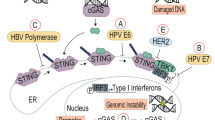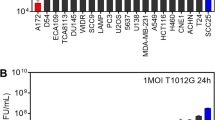Abstract
Replication-competent oncolytic viruses hold great potential for the clinical treatment of many cancers. Importantly, many oncolytic virus candidates, such as reovirus and myxoma virus, preferentially infect cancer cells bearing abnormal cellular signaling pathways. Reovirus and myxoma virus are highly responsive to activated Ras and Akt signaling pathways, respectively, for their specificity for viral oncolysis. However, considering the complexity of cancer cell populations, it is possible that other tumor-specific signaling pathways may also contribute to viral discrimination between normal versus cancer cells. Because carcinogenesis is a multistep process involving the accumulation of both oncogene activations and the inactivation of tumor suppressor genes, we speculated that not only oncogenes but also tumor suppressor genes may have an important role in determining the tropism of these viruses for cancer cells. It has been previously shown that many cellular tumor suppressor genes, such as p53, ATM and Rb, are important for maintaining genomic stability; dysfunction of these tumor suppressors may disrupt intact cellular antiviral activity due to the accumulation of genomic instability or due to interference with apoptotic signaling. Therefore, we speculated that cells with dysfunctional tumor suppressors may display enhanced susceptibility to challenge with these oncolytic viruses, as previously seen with adenovirus. We report here that both reovirus and myxoma virus preferentially infect cancer cells bearing dysfunctional or deleted p53, ATM and Rb tumor suppressor genes compared to cells retaining normal counterparts of these genes. Thus, oncolysis by these viruses may be influenced by both oncogenic activation and tumor suppressor status.
This is a preview of subscription content, access via your institution
Access options
Subscribe to this journal
Receive 50 print issues and online access
$259.00 per year
only $5.18 per issue
Buy this article
- Purchase on Springer Link
- Instant access to full article PDF
Prices may be subject to local taxes which are calculated during checkout




Similar content being viewed by others
Abbreviations
- WT reovirus:
-
wild-type reovirus
- AV reovirus:
-
S1 attenuated reovirus
- Myx:
-
myxoma virus
- Myx-GFP:
-
GFP-expressing myxoma virus
- MOI:
-
multiplicity of infection
References
Abou El Hassan MA, van der Meulen-Muileman I, Abbas S, Kruyt FA . (2004). Conditionally replicating adenoviruses kill tumor cells via a basic apoptotic machinery-independent mechanism that resembles necrosis-like programmed cell death. J Virol 78: 12243–12251.
Alain T, Hirasawa K, Pon KJ, Nishikawa SG, Urbanski SJ, Auer Y et al. (2002). Reovirus therapy of lymphoid malignancies. Blood 100: 4146–4153.
Beà S, Salaverria I, Armengol L, Pinyol M, Fernández V, Hartmann EM et al. (2009). Uniparental disomies, homozygous deletions, amplifications, and target genes in mantle cell lymphoma revealed by integrative high-resolution whole-genome profiling. Blood 113: 3059–3069.
Bischoff JR, Kirn DH, Williams A, Heise C, Horn S, Muna M et al. (1996). An adenovirus mutant that replicates selectively in p53-deficient human tumor cells. Science 274: 373–376.
Carroll PE, Okuda M, Horn HF, Biddinger P, Stambrook PJ, Gleich LL et al. (1999). Centrosome hyperamplification in human cancer: chromosome instability induced by p53 mutation and/or Mdm2 overexpression. Oncogene 18: 1935–1944.
Coffey MC, Strong JE, Forsyth PA, Lee PW . (1998). Reovirus therapy of tumors with activated Ras pathway. Science 282: 1332–1334.
Dharel N, Kato N, Muroyama R, Taniguchi H, Otsuka M, Wang Y et al. (2008). Potential contribution of tumor suppressor p53 in the host defense against hepatitis C virus. Hepatology 47: 1136–1149.
Duursma AM, Agami R . (2003). Ras interference as cancer therapy. Semin Cancer Biol 13: 267–273.
Duncan MR, Stanish SM, Cox DC . (1978). Differential sensitivity of normal and transformed human cells to reovirus infection. J Virol 28: 444–449.
Forsyth P, Roldán G, George D, Wallace C, Palmer CA, Morris D et al. (2008). Phase I trial of intratumoral administration of reovirus in patients with histologically confirmed recurrent malignant gliomas. Mol Ther 16: 627–632.
Hashiro G, Loh PC, Yau JT . (1977). The preferential cytotoxicity of reovirus for certain transformed cell lines. Arch Virol 54: 307–315.
Huang S, Qu LK, Koromilas AE . (2004). Induction of p53-dependent apoptosis in HCT116 tumor cells by RNA viruses and possible implications in virus mediated oncolysis. Cell Cycle 3: 1043–1045.
Johnston JB, Barrett JW, Chang W, Chung CS, Zeng W, Masters J et al. (2003). Role of the serine-threonine kinase PAK-1 in myxoma virus replication. J Virol 77: 5877–5888.
Kim M, Alain T, Urbanski SJ, Kossakowska AE, Lee PWK, Forsyth PA et al. (2007a). An attenuated reovirus isolated from persistent reovirus infection exerts viral oncolysis with reduced pathogenicity. American Society for Virology (ASV) 2007 Annual Meeting; July 2007; Oregon State University: Corvallis, OR.
Kim M, Egan C, Alain T, Urbanski SJ, Lee PW, Forsyth PA et al. (2007b). Acquired resistance to reoviral oncolysis in Ras-transformed fibrosarcoma cells. Oncogene 26: 4124–4134.
Kim M, Madlambayan GJ, Rahman MM, Smallwood SE, Meacham AM, Hosaka K et al. (2009). Myxoma virus targets primary human leukemic stem and progenitor cells while sparing normal hematopoietic stem and progenitor cells. Leukemia 23: 2313–2317.
Kitagawa R, Kastan MB . (2005). The ATM-dependent DNA damage signaling pathway. Cold Spring Harb Symp Quant Biol 70: 99–109.
Kozlov S, Gueven N, Keating K, Ramsay J, Lavin MF . (2003). ATP activates ataxia-telangiectasia mutated (ATM) in vitro. Importance of autophosphorylation. J Biol Chem 278: 9309–9317.
Li DW, Liu JP, Schmid PC, Schlosser R, Feng H, Liu WB et al. (2006). Protein serine/threonine phosphatase-1 dephosphorylates p53 at Ser-15 and Ser-37 to modulate its transcriptional and apoptotic activities. Oncogene 25: 3006–3022.
Lun X, Yang W, Alain T, Shi ZQ, Muzik H, Barrett JW et al. (2005). Myxoma virus is a novel oncolytic virus with significant antitumor activity against experimental human gliomas. Cancer Res 65: 9982–9990.
Lun XQ, Zhou H, Alain T, Sun B, Wang L, Barrett JW et al. (2007). Targeting human medulloblastoma: oncolytic virotherapy with myxoma virus is enhanced by rapamycin. Cancer Res 67: 8818–8827.
McCormick F . (2005). Future prospects for oncolytic therapy. Oncogene 24: 7817–7819.
McFadden G . (2005). Poxvirus tropism. Nat Rev Microbiol 3: 201–213.
Morris SM . (2002). A role for p53 in the frequency and mechanism of mutation. Mutat Res 511: 45–62.
Muñoz-Fontela C, Macip S, Martínez-Sobrido L, Brown L, Ashour J, García-Sastre A et al. (2008). Transcriptional role of p53 in interferon-mediated antiviral immunity. J Exp Med 205: 1929–1938.
Norman KL, Hirasawa K, Yang AD, Shields MA, Lee PW . (2004). Reovirus oncolysis: the Ras/RalGEF/p38 pathway dictates host cell permissiveness to reovirus infection. Proc Natl Acad Sci USA 101: 11099–11104.
Norman KL, Lee PW . (2005). Not all viruses are bad guys: the case for reovirus in cancer therapy. Drug Discov Today 10: 847–855.
O′Shea CC, Johnson L, Bagus B, Choi S, Nicholas C, Shen A et al. (2004). Late viral RNA export, rather than p53 inactivation, determines ONYX-015 tumor selectivity. Cancer Cell 6: 611–623.
Reid TW, Albert DM, Rabson AS, Russell P, Craft J, Chu EW et al. (1974). Characteristics of an established cell line of retinoblastoma. J Natl Cancer Inst 53: 347–360.
Royds JA, Hibma M, Dix BR, Hananeia L, Russell IA, Wiles A et al. (2006). p53 promotes adenoviral replication and increases late viral gene expression. Oncogene 25: 1509–1520.
Shmulevitz M, Marcato P, Lee PW . (2010). Activated Ras signaling significantly enhances reovirus replication and spread. Cancer Gene Ther 17: 69–70.
Song L, Ohnuma T, Gelman IH, Holland JF . (2009). Reovirus infection of cancer cells is not due to activated Ras pathway. Cancer Gene Ther 16: 382.
Strong JE, Coffey MC, Tang D, Sabinin P, Lee PW . (1998). The molecular basis of viral oncolysis: usurpation of the Ras signaling pathway by reovirus. EMBO J 17: 3351–3362.
Strong JE, Lee PWK . (1996). The v-erbB oncogene confers enhanced cellular susceptibility to reovirus infection. J Virol 70: 612–616.
Strong JE, Tang D, Lee PWK . (1993). Evidence that the epidermal growth factor receptor on host cells confers reovirus infection efficiency. Virology 197: 405–411.
Stanford M, Shaban M, Barrett JW, Gilbert PA, Bondy-Denomy J, Mackenzie L et al. (2008). Myxoma virus oncolysis of primary and metastatic B16F10 mouse tumors in vivo. Mol Ther 16: 52–59.
Stanford MM, McFadden G . (2007). Myxoma virus and oncolytic virotherapy: a new biologic weapon in the war against cancer. Expert Opin Biol Ther 7: 1415–1425.
Sypula J, Wang F, Ma Y, Bell J, McFadden G . (2004). Myxoma virus tropism in human tumor cells. Gene Ther Mol Biol 8: 103–114.
Takaoka A, Hayakawa S, Yanai H, Stoiber D, Negishi H, Kikuchi H et al. (2003). Integration of interferon-alpha/beta signalling to p53 responses in tumour suppression and antiviral defence. Nature 424: 516–523.
Tucker CA, Bebb G, Klasa RJ, Chhanabhai M, Lestou V, Horsman DE et al. (2006). Four human t(11;14)(q13;q32)-containing cell lines having classic and variant features of mantle cell lymphoma. Leuk Res 30: 449–457.
Vidal L, Pandha HS, Yap TA, White CL, Twigger K, Vile RG et al. (2008). A phase I study of intravenous oncolytic reovirus type 3 Dearing in patients with advanced cancer. Clin Cancer Res 14: 7127–7137.
Wang F, Barrett JW, Ma Y, Dekaban GA, McFadden G . (2009). Induction of alpha/beta interferon by myxoma virus is selectively abrogated when primary mouse embryo fibroblasts become immortalized. J Virol 83: 5928–5932.
Wang G, Barrett JW, Stanford M, Werden SJ, Johnston JB, Gao X et al. (2006). Infection of human cancer cells with myxoma virus requires Akt activation via interaction with a viral ankyrin-repeat host range factor. Proc Natl Acad Sci USA 103: 4640–4645.
White E . (1994). Tumour biology. p53, guardian of Rb. Nature 371: 21–22.
Acknowledgements
This work was supported by funding from the Canadian Institutes of Health Research and the Canadian Breast Cancer Foundation (to RNJ) and a start-up grant from the University of Florida College of Medicine and NIH grant R01 CA138541 (to GM). GM is an International Scholar of the Howard Hughes Medical Institute.
Author information
Authors and Affiliations
Corresponding author
Ethics declarations
Competing interests
The authors declare no conflict of interest.
Rights and permissions
About this article
Cite this article
Kim, M., Williamson, C., Prudhomme, J. et al. The viral tropism of two distinct oncolytic viruses, reovirus and myxoma virus, is modulated by cellular tumor suppressor gene status. Oncogene 29, 3990–3996 (2010). https://doi.org/10.1038/onc.2010.137
Received:
Revised:
Accepted:
Published:
Issue Date:
DOI: https://doi.org/10.1038/onc.2010.137
Keywords
This article is cited by
-
Antitumor effects of IL-12 and GM-CSF co-expressed in an engineered oncolytic HSV-1
Gene Therapy (2021)
-
Identification of host DEAD-box RNA helicases that regulate cellular tropism of oncolytic Myxoma virus in human cancer cells
Scientific Reports (2017)
-
Reovirus safety study for proliferation and differentiation of human adipose-derived mesenchymal stem cells
Journal of Microbiology (2017)
-
Evidence for differential viral oncolytic efficacy in an in vitro model of epithelial ovarian cancer metastasis
Molecular Therapy - Oncolytics (2015)
-
Replicating poxviruses for human cancer therapy
Journal of Microbiology (2015)



